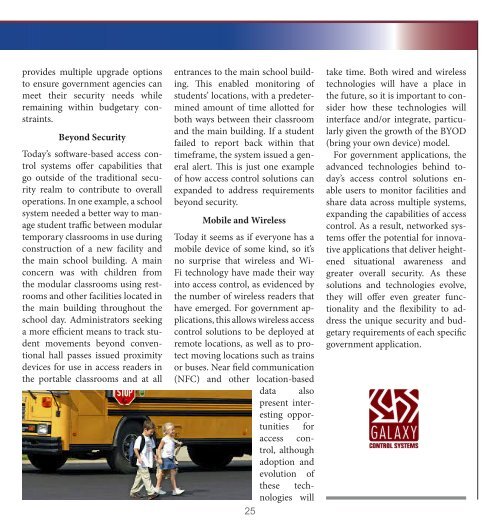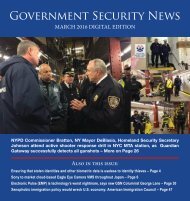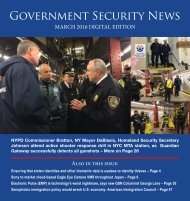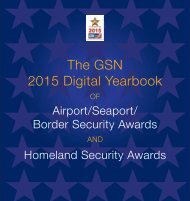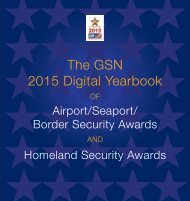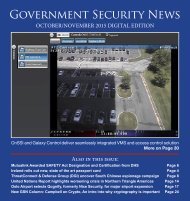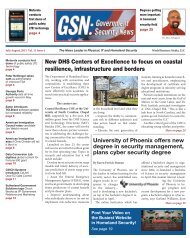GSN January 2016 Digital Edition
You also want an ePaper? Increase the reach of your titles
YUMPU automatically turns print PDFs into web optimized ePapers that Google loves.
provides multiple upgrade options<br />
to ensure government agencies can<br />
meet their security needs while<br />
remaining within budgetary constraints.<br />
Beyond Security<br />
Today’s software-based access control<br />
systems offer capabilities that<br />
go outside of the traditional security<br />
realm to contribute to overall<br />
operations. In one example, a school<br />
system needed a better way to manage<br />
student traffic between modular<br />
temporary classrooms in use during<br />
construction of a new facility and<br />
the main school building. A main<br />
concern was with children from<br />
the modular classrooms using restrooms<br />
and other facilities located in<br />
the main building throughout the<br />
school day. Administrators seeking<br />
a more efficient means to track student<br />
movements beyond conventional<br />
hall passes issued proximity<br />
devices for use in access readers in<br />
the portable classrooms and at all<br />
entrances to the main school building.<br />
This enabled monitoring of<br />
students’ locations, with a predetermined<br />
amount of time allotted for<br />
both ways between their classroom<br />
and the main building. If a student<br />
failed to report back within that<br />
timeframe, the system issued a general<br />
alert. This is just one example<br />
of how access control solutions can<br />
expanded to address requirements<br />
beyond security.<br />
Mobile and Wireless<br />
Today it seems as if everyone has a<br />
mobile device of some kind, so it’s<br />
no surprise that wireless and Wi-<br />
Fi technology have made their way<br />
into access control, as evidenced by<br />
the number of wireless readers that<br />
have emerged. For government applications,<br />
this allows wireless access<br />
control solutions to be deployed at<br />
remote locations, as well as to protect<br />
moving locations such as trains<br />
or buses. Near field communication<br />
(NFC) and other location-based<br />
data also<br />
present interesting<br />
opportunities<br />
for<br />
access control,<br />
although<br />
adoption and<br />
evolution of<br />
these technologies<br />
will<br />
25<br />
take time. Both wired and wireless<br />
technologies will have a place in<br />
the future, so it is important to consider<br />
how these technologies will<br />
interface and/or integrate, particularly<br />
given the growth of the BYOD<br />
(bring your own device) model.<br />
For government applications, the<br />
advanced technologies behind today’s<br />
access control solutions enable<br />
users to monitor facilities and<br />
share data across multiple systems,<br />
expanding the capabilities of access<br />
control. As a result, networked systems<br />
offer the potential for innovative<br />
applications that deliver heightened<br />
situational awareness and<br />
greater overall security. As these<br />
solutions and technologies evolve,<br />
they will offer even greater functionality<br />
and the flexibility to address<br />
the unique security and budgetary<br />
requirements of each specific<br />
government application.


